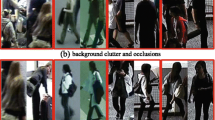Abstract
Person re-identification (re-id) aims to identity the same person over multiple cameras; it has been successfully applied to various computer vision applications as a fundamental method. Owing to the development of deep learning, person re-id methods, which typically use triplet networks based on triplet loss, have demonstrated great success. However, the appearances of people are similar and hence difficult to distinguish in many cases. Therefore, we present a novel graph convolution network and enhances traditional triplet loss functions. Our method defines reference, positive, and negative features for triplet loss as three vertices of a graph, respectively, and adjusts their mutual distance through learning. The method adopts graph convolutions efficiently, thereby affording low computational costs. Experimental results demonstrate that our method is superior to the baseline on the Market-1501 dataset. The proposed GCN-based triplet loss considerably contributes to improve re-identification methods quantitatively and qualitatively.



Similar content being viewed by others
References
Bai S, Bai X, Tian Q (2017) Scalable person re-identification on supervised smoothed manifold. In: CVPR
Barbosa I, Cristani M, Caputo B, Rognhaugen A, Theoharis T (2017) Looking beyond appearances:, Synthetic training data for deep cnns in re-identification. arXiv:1701.03153
Chen W, Chen X, Zhang J, Huang K (2017) Beyond triplet loss: a deep quadruplet network for person re-identification. In: CVPR
Chen Y, Zhu X, Gong S (2017) Person re-identification by deep learning multi-scale representations. In: ICCV
Fan X, Jiang W, Luo H, Mao W, Yu H (2020) Instance hard triplet loss for in-video person re-identification. Appl Sci 10(6):2198
Hermans A, Beyer L, Leibe B (2017) In defense of the triplet loss for person re-identification. arXiv:1703.07737
Hou R, Ma B, Chang H, Gu X, Shan S, Chen X (2019) VRSTC: Occlusion-free Video person re-identification. In: CVPR
Jiang B, Wang X, Luo B (2019) PH-GCN:, Person re-identification with part-based hierarchical graph convolutional network. arXiv:1907.08822
Li W, Zhu X, Gong S (2017) Person re-identification by deep joint learning of multi-loss classification. arXiv:1705.04724
Li Y, Song Y, Luo J (2017) Improving pairwise ranking for multi-label image classification. In: CVPR
Liu J, Ni B, Yan Y, Zhou P, Cheng S, Hu J (2018) Pose transferrable person re-identification . In: CVPR
Liu X, Liu W, Ma H, Fu H (2016) Large scale vehicle re-identification in urban surveillance videos. In: ICME
Liu X, Zhao H, Tian M, Sheng L, Shao J, Yi S, Yan J, Wang X (2017) Hydraplus-net: Attentive deep features for pedestrian analysis. In: ICCV
Ristani E, Solera F, Zou RS, Cucchiara R, Tomasi C (2016) Performance measures and a data set for multi-target, multi-camera tracking. In: ECCV Workshops
Ristani E, Tomasi C (2018) Features for multi-target multi-camera tracking and re-identification. In: CVPR
Schroff F, Kalenichenko D, Philbin J (2015) FaceNnet: A unified embedding for face recognition and clustering. In: CVPR
Shen Y, Li H, Yi S, Chen D, Wang X (2018) Person re-identification with deep similarity-guided graph neural network. In: ECCV
Su C, Li J, Zhang S, Xing J, Gao W, Tian Q (2017) Pose-driven deep convolutional model for person re-identification. In: ICCV
Sun Y, Zheng L, Deng W, Wang S (2017) SVDNEt for pedestrian retrieval. In: ICCV
Varior R, Haloi M, Wang G (2016) Gated siamese convolutional neural network architecture for human reidentification. In: ECCV
Wang Y, Chen Z, Wu F, Wang G (2018) Person re-identification with cascaded pairwise convolutions. In: CVPR
Wojke N, Bewley A (2018) Deep cosine metric learning for person re-identification. In: WACV
Xiao Q, Luo H, Zhang C (2017) Margin sample mining loss:, A deep learning based method for person re-identification. arXiv:1710.00478
Xiao T, Li S, Wang B, Lin L, Wang X (2016) End-to-end deep learning for person search. arXiv:1604.01850
Yang J, Zheng W, Yang Q, Chen Y, Tian Q (2020) Spatial-temporal graph convolutional network for video-based person re-identification. In: CVPR
Ye M, Li J, Ma A, Zheng L, Yuen P (2019) Dynamic graph co-matching for unsupervised video-based person re-identification. IEEE Trans Image Process 28(6):2976–2990
Yu R, Dou Z, Bai S, Zhang Z, Xu Y, Bai X (2018) Hard-aware point-to-set deep metric for person re-identification. In: ECCV
Zhai Y, Guo X, Lu Y, Li H (2019) In defense of the classification loss for person re-identification. In: CVPRW
Zhang L, Xiang T, Gong S (2016) Learning a discriminative null space for person re-identification. In: CVPR
Zhao L, Li X, Zhuang Y, Wang J (2017) Deeply-learned part-aligned representations for person re-identification. In: ICCV
Zheng L, Shen L, Tian L, Wang S, Wang J, Tian Q (2015) Scalable person re-identification: a benchmark. In: ICCV
Zheng Z, Zheng L, Yang Y (2017) Pedestrian alignment network for large-scale person re-identification. arXiv:1707.00408
Zhong Z, Zheng L, Cao D, Li S (2017) Re-ranking person reidentification with k-reciprocal encoding. In: CVPR
Zhou S, Wang J, Wang J, Gong Y, Zheng N (2017) Point to set similarity based deep feature learning for person reidentification. In: CVPR
Acknowledgments
This work was partly supported by the Chung-Ang University Graduate Research Scholarship Grants in 2018 and partly supported by the National Research Foundation of Korea (NRF) grant funded by the Korea government(MSIT) (NRF-2020R1C1C1004907).
Author information
Authors and Affiliations
Corresponding author
Additional information
Publisher’s note
Springer Nature remains neutral with regard to jurisdictional claims in published maps and institutional affiliations.
Rights and permissions
About this article
Cite this article
Kim, G., Shu, D.W. & Kwon, J. Robust person re-identification via graph convolution networks. Multimed Tools Appl 80, 29129–29138 (2021). https://doi.org/10.1007/s11042-021-11127-0
Received:
Revised:
Accepted:
Published:
Issue Date:
DOI: https://doi.org/10.1007/s11042-021-11127-0




